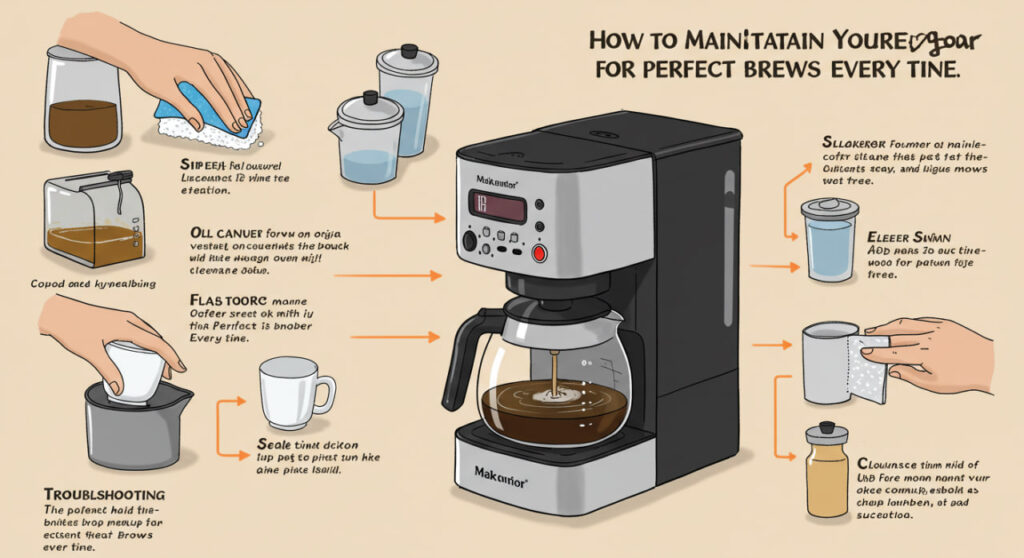For coffee enthusiasts, a well-maintained coffee maker is the key to consistently delicious brews. Whether you’re using a drip machine, a French press, or an espresso maker, regular maintenance ensures optimal performance, extends the lifespan of your device, and preserves the rich flavors of your coffee. Neglecting upkeep can lead to bitter brews, clogged components, or even costly repairs. In this comprehensive guide, we’ll walk you through the essential steps to keep your coffee maker in top shape, delivering perfect cups every time. From daily cleaning routines to deep descaling, here’s everything you need to know to maintain your coffee maker like a pro.
Why Coffee Maker Maintenance Matters
Regular maintenance isn’t just about keeping your coffee maker shiny; it directly impacts the quality of your coffee. Over time, coffee oils, mineral deposits from water, and leftover grounds can build up inside your machine. These residues can alter the taste of your brew, making it bitter or stale, and may even harbor bacteria if left unchecked. Additionally, mineral buildup, known as limescale, can clog internal components, reducing efficiency and potentially damaging your machine. By dedicating a little time to cleaning and care, you’ll ensure your coffee maker performs at its best, delivering the rich, aromatic coffee you love while avoiding premature replacements.
The Impact of Neglect on Coffee Quality
When coffee grounds and oils accumulate, they can become rancid, imparting off-flavors to your brew. Hard water, commonly used in many households, leaves behind calcium and magnesium deposits that affect water flow and temperature consistency—two critical factors for a great cup of coffee. A poorly maintained machine may also struggle to heat water properly, resulting in under-extracted coffee that tastes weak or sour. Regular cleaning eliminates these issues, ensuring every sip is as flavorful as intended.
Daily Cleaning Routine for Your Coffee Maker
A simple daily cleaning routine can prevent buildup and keep your coffee maker in excellent condition. After each use, take a few minutes to clean the removable parts and wipe down the machine. This small effort goes a long way in maintaining both hygiene and performance.
Step 1: Empty and Rinse Removable Parts
Start by unplugging your coffee maker for safety. Remove detachable components like the carafe, filter basket, or water reservoir. Rinse them thoroughly with warm water to remove coffee grounds and oils. For stubborn stains, use a mild dish soap and a soft sponge, avoiding abrasive scrubbers that could scratch glass or plastic surfaces. Dry these parts with a clean cloth to prevent water spots or mold growth.
Step 2: Wipe Down the Exterior
Use a damp cloth to wipe the exterior of the machine, focusing on areas prone to splashes or spills, like the brew basket area and control panel. For stainless steel models, a microfiber cloth works best to avoid streaks. Be sure to clean around buttons and crevices where coffee residue can accumulate. This quick wipe-down keeps your machine looking pristine and prevents sticky buildup.
Monthly Deep Cleaning for Optimal Performance
While daily cleaning handles surface-level maintenance, a monthly deep clean tackles hidden buildup inside your coffee maker. This process involves cleaning hard-to-reach areas and ensuring internal components remain free of debris.
Cleaning the Brew Basket and Permanent Filters
If your coffee maker has a permanent filter or reusable brew basket, give it extra attention during your monthly routine. Soak these parts in a solution of equal parts water and white vinegar for 10–15 minutes to dissolve oils and stains. Scrub gently with a soft brush to remove any remaining residue, then rinse thoroughly and dry. This step ensures that old coffee grounds don’t compromise the flavor of your brew.
Cleaning the Carafe and Water Reservoir
For glass or thermal carafes, fill them with warm water and a few drops of dish soap, then use a bottle brush to scrub the interior. For tough coffee stains, add a tablespoon of baking soda to the mix—it’s a gentle abrasive that lifts stains without scratching. Rinse thoroughly to avoid soapy residue. Similarly, clean the water reservoir with a vinegar-water solution, letting it sit for a few minutes before rinsing. This prevents mold and bacteria from forming in the moist environment.

Descaling Your Coffee Maker
Descaling is a critical maintenance step that removes limescale buildup caused by minerals in water. Depending on your water hardness and usage frequency, descale your coffee maker every 1–3 months for optimal performance.
How to Descale with Vinegar
White vinegar is an affordable and effective descaling agent. Mix equal parts water and white vinegar, then pour the solution into the water reservoir. Run a brew cycle without coffee grounds, allowing the solution to flow through the machine. Halfway through, pause the cycle and let the vinegar sit for 20–30 minutes to break down mineral deposits. Complete the cycle, then run 2–3 cycles with clean water to flush out any vinegar taste or odor. For heavily scaled machines, repeat the process.
Alternative Descaling Solutions
If you prefer a commercial descaling product, brands like Keurig or De’Longhi offer specialized solutions designed for coffee makers. Follow the product instructions carefully, as concentrations and brewing times may vary. These products are often formulated to be gentler on internal components while effectively removing limescale. Always rinse thoroughly after using any descaling solution to ensure no chemical residue remains.
Special Considerations for Different Coffee Makers
Not all coffee makers are created equal, and maintenance needs vary depending on the type of machine you own. Here’s how to care for some popular models.
Drip Coffee Makers
Drip coffee makers are straightforward to maintain, as most have removable parts that are easy to clean. Focus on descaling regularly, as these machines are prone to limescale buildup due to frequent water use. Check the manufacturer’s manual for specific cleaning instructions, as some models have unique features like self-cleaning cycles.
Espresso Machines
Espresso machines require extra care due to their complex components. Clean the portafilter and steam wand after each use to prevent milk residue or coffee oil buildup. Descaling is especially important, as limescale can clog the machine’s boiler and affect pressure, resulting in weak espresso shots. Some high-end models include cleaning tablets or backflushing instructions—follow these for best results.
French Press and Pour-Over Devices
For manual coffee makers like French presses or pour-over cones, maintenance is simpler but still essential. Disassemble the French press and clean the mesh filter thoroughly to remove fine coffee particles. Soak in a vinegar solution monthly to prevent oil buildup. Pour-over devices should be rinsed after each use and scrubbed with a soft brush to maintain smooth water flow.
Tips for Long-Term Coffee Maker Care
Beyond regular cleaning, a few habits can extend the life of your coffee maker and enhance your brewing experience.
Use Filtered Water
Using filtered or bottled water reduces mineral buildup, especially in areas with hard water. This not only improves the taste of your coffee but also minimizes the need for frequent descaling. If filtered water isn’t an option, consider installing a water softener for your home.
Store Properly
If you’re not using your coffee maker for an extended period, empty the water reservoir and dry all components thoroughly to prevent mold. Store the machine in a cool, dry place, and avoid stacking heavy items on top to prevent damage to delicate parts.
Replace Worn Parts
Over time, seals, gaskets, or filters may wear out. Check your manufacturer’s website for replacement parts specific to your model. Regularly inspect your machine for signs of wear, such as cracks in the carafe or loose fittings, and address them promptly to avoid leaks or malfunctions.
Troubleshooting Common Coffee Maker Issues
Even with proper maintenance, you may encounter occasional issues. Here are some common problems and how to fix them.
Slow Brewing
If your coffee maker is brewing slower than usual, limescale buildup is likely the culprit. Run a descaling cycle with vinegar or a commercial solution. If the problem persists, check the water reservoir and tubing for blockages and clean thoroughly.
Bitter or Off-Tasting Coffee
Bitter coffee often results from leftover grounds or oils. Clean the brew basket, filter, and carafe thoroughly. If the issue continues, ensure you’re using fresh, high-quality coffee beans and storing them in an airtight container to prevent staleness.
FAQ
How often should I descale my coffee maker?
Descale every 1–3 months, depending on your water hardness and frequency of use. If you notice slower brewing or weaker coffee, descale sooner.
Can I use something other than vinegar for descaling?
Yes, commercial descaling solutions are effective and often gentler on your machine. Follow the product’s instructions and rinse thoroughly afterward.
Is it safe to put coffee maker parts in the dishwasher?
Check your manufacturer’s manual. Some carafes and filter baskets are dishwasher-safe, but delicate components like reservoirs or permanent filters may require hand washing to avoid damage.
Why does my coffee taste bitter even after cleaning?
Bitter coffee can result from rancid oils, stale beans, or improper brewing temperature. Ensure your machine is clean, use fresh coffee, and check if the water temperature is consistent.
How do I know if my coffee maker needs replacing?
If your machine frequently clogs, leaks, or fails to brew properly despite thorough cleaning and descaling, it may be time for a replacement. Most coffee makers last 5–10 years with proper care.
By following these maintenance tips, you’ll keep your coffee maker in peak condition, ensuring every brew is as flavorful and satisfying as the first. A little effort goes a long way in preserving both your machine and your morning ritual.



